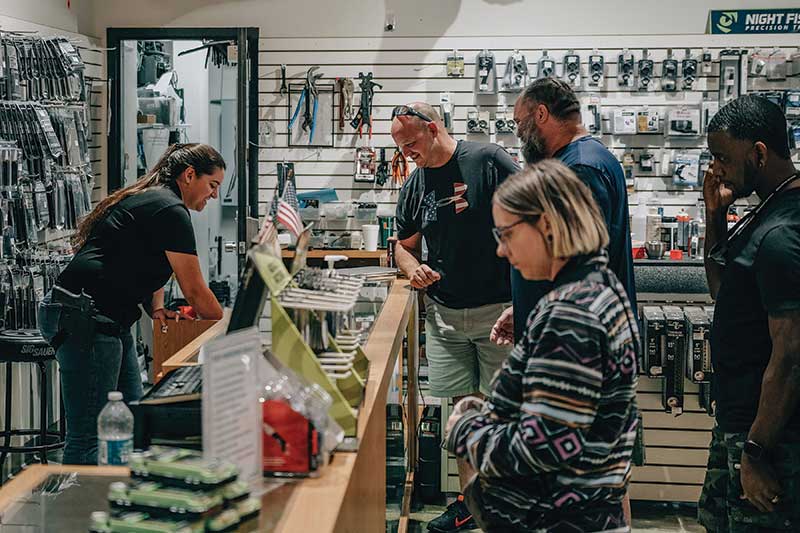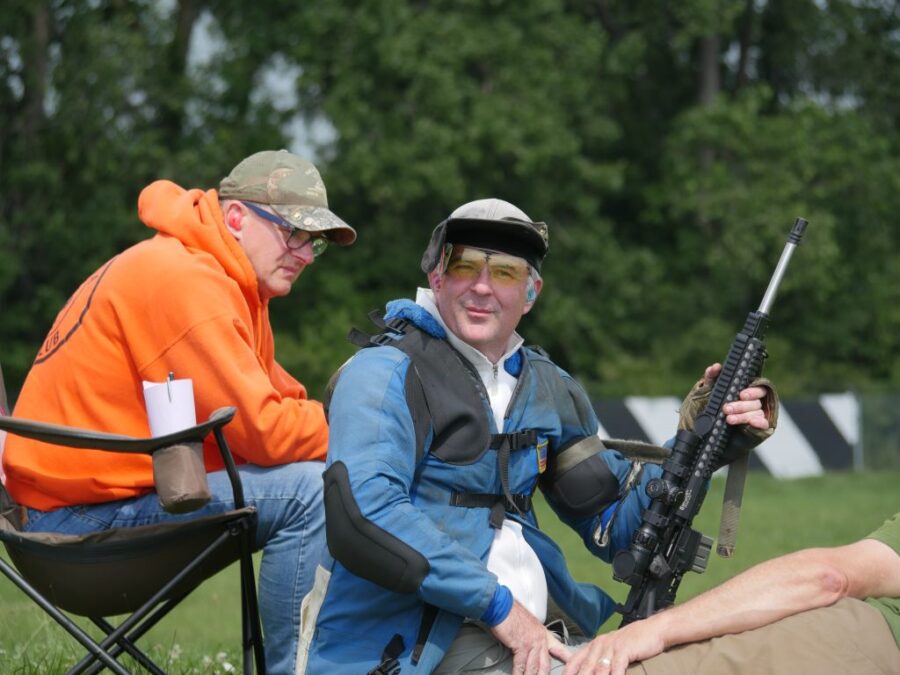Margin Boosters
Creatively Combat Thinning Profits
With MAP-Supported Products
Let’s think back to “normal” times in the gun business. Imagine a scenario where your firearms department was really humming along, advertising was working (bringing in customers with means to buy), you had a good, expanded staff (a big feat nowadays) to service those customers and the most popular firearms in stock to sell. Sounds like the perfect dream.
But how did it turn out when it came time to look over the numbers and see how much money was left for the business, after paying all the bills? Did your dream become a nightmare? All the hard work, all the guns sold, all the risk you took bringing inventory in — if the money was coming in strong, why, then, is your wallet not bulging into your backside when you sit down?
I would hazard a guess one of the main reasons for the wafer-thin wallet is the thin margin you sold the firearms for and lack of selling enough accessories or services to keep the margin respectable. Before the pandemic hit, most brick-and-mortar stores were in the neighborhood of 12% to 20% margin for new firearms, depending on specific model and category. Is this enough reward for all your efforts and risk?
Doing The Math
Part of the answer to this question may be found in how much it actually costs your particular operation to sell a firearm.
Each business will come up with a different number depending on amount of technology used, how you allocate labor costs, cost of your money, insurance, current capital situation and so on. I’ve heard numbers in the $40 to $50 range, per firearm.
Now consider a few years back when many popular firearms sold for $500 and up, you could take the $40 to $50 selling cost out and still have a little profit left.
Fast-forward to current times — when many popular firearms sell in the $300 range — you can quickly see there isn’t $40 to $50 worth of meat left on the bone to cover your expenses, let alone keep any money in your wallet.
What to do about it? We can complain (as many have for the 40 years I’ve been in the industry) or we can look at some options to improve our lot. Many reading this article are able to at least influence, if not actually control, what happens in your businesses.
If you don’t like the margin you’re making on a certain brand or model, you always have the option to not sell it. Easier said than done, but it’s something you control, compared to what price a particular firearm is sold for — over which you have very little control.
“If you don’t like the margin you’re making on a certain brand or model, you always have the option to not sell it.”
Advantage Of MAP Focus
One option would be to only sell brands with MAP (Minimum Advertised Price) and you’re comfortable with the margin it affords you. SIG SAUER, GLOCK and SAR USA are three brands currently offering MAP protection. Theoretically, with a MAP-protected item, the retailer is promised the brand won’t allow others to drive the price down below a certain point and the manufacturer’s brand is protected from being seen as a “discount brand.”
Jason Baum, operations manager for the three Nardis Gun Club locations in San Antonio, Texas, has had good success focusing heavily on MAP-protected firearms. He’s also using this method to decide which accessories to stock, having been burned too many times when the ones he had could be purchased on Amazon for less than he paid for them.
Other retailers like Ethan Sansoni, general manager at FrogBones Family Shooting Center in Melbourne, Fla., have a conflicted relationship with MAP. On one hand, Sansoni is a big supporter of brands like SIG and appreciates the extra margin he can make on MAP products — even though it can be a pain for internet sales purposes. He appreciates companies like SIG are helping raise and enforce the tides of fair margins for their dealers. However, on the other hand he’s a capitalist and doesn’t agree with being told what he can and cannot sell something for, saying simply, “It’s complicated.”
One Drawback
A drawback to MAP products comes if you’re overstocked with said SKU — as your options are limited. The popular “drop the price to blow them out” approach is off the table (unless the manufacturer offers a “MAP holiday” to lower the price), so you’ll need to find other options to turn this inventory into cash.
MAP holidays, where the manufacturer promotes a window of time where all sellers can violate MAP to drive sales, can work well if you’re a retailer who has overbought or undersold and needs to move inventory out. On the other side of the coin, however, this negatively impacts the retailer who did a great job of managing their inventory — and now their profits are hurt because others are dropping the price below MAP.
Another consideration with MAP items: Is the MAP enough of a margin for your operation? As discussed above, depending on your operation, your cost to sell a firearm may be high enough even selling at MAP won’t leave you enough meat on the bone. Of course, you can always sell above MAP, although it seems once MAP is set many retailers go down to that number right off the bat.
“MAP holidays can work well if you’re a retailer who has overbought or undersold and needs to move inventory out.”
The Manufacturer’s Perspective
Ever wonder how a manufacturer sets MAP? To find out, we asked Todd Pearson, SAR USA COO, to share how they determine MAP pricing.
“MAP is a critical tool to ensure profitability in the sales cycle,” he stated. “There has to be a reason to support a brand. At SAR USA we determined early on we must make the sales channel profitable for all. We set aggressive price points to support all phases of the cycle with better-than-market margins. We start with retail price points where we feel our brand best supports. Then we plug in the dealer and distributor margin. It’s our formula for pricing.”
TWO-PRONGED Approach To Margins
Paul Bastean, managing director of Ultimate Defense Firing Range & Training Center (St. Peters, Mo.), is one who really looks over the profitability of each department in his operation. Bastean takes a two-pronged approach to firearms margins. He made the choice to only stock brands/models of new firearms that he makes enough margin on and doesn’t put any effort into selling those that don’t offer enough margin.
Bastean also put a huge amount of effort into buying and selling used firearms, where his margins are usually over double new firearms. Could he sell more new firearms if he stocked the lower-margin brands/models? Probably, but he’d also have more overhead — and more headaches.
Lower-margin firearms also frequently require a disproportionate amount of support from staff after the sale. Sending firearms back to the manufacturer because of function issues, broken parts or cosmetic flaws takes time. Making contact with the warranty department, getting return authorization, describing the specific issue and packing and shipping all eat up valuable staff time. And, the client is displeased with having made a purchase that didn’t meet expectations. In these cases, the factional amount of margin is more than consumed in service after the sale.
Some will argue he also would sell more high-margin accessories by selling more firearms overall. I can’t disagree with this logic, provided your staff is trained to sell accessories with each and every firearm. For Bastean, doing less volume of lower-margin guns and turning some consumers looking for lower-margin models to buying used guns and stocking less inventory with lower overhead and more profit margin per unit continues to make the most dollars and sense.
A Package Deal
While used firearms is most likely the number-one way retailers can make up for margin pressure, spending time and energy on firearms packages the retailers themselves make up is another good way to improve margin.
How is making your own packages vastly different from selling a package put together by a manufacturer, you ask? A package from the manufacturer — say a firearm, extra magazines, holster and flashlight — are generally sold as a package at the margin of a new firearm (12% to 20%), so the retailer gives up the 30% to 40% margin on the accessories. Contrast this to a package the retailer puts together.
A forward-thinking retailer can buy cases, optics, cleaning kits and many other accessories at special pricing throughout the year, package it together with the new firearm and raise the margin substantially over manufacturer prepackages — plus have something different from other retailers.
An example would be a GLOCK 26 (or pick your favorite gun), add a grip extension, wraparound grip, night sights, concealed carry holster and advertise it as a “Night Stinger.” If you have a range add training to the equation, the possibilities are endless.
Speaking of ranges, some range owners have stepped away from focusing on firearms, becoming more of a limited pro shop and doubling their efforts into the range — with both walk-ins and memberships — along with training. One range that is franchising, Shoot Indoors, is taking it to the extreme, with a requirement the franchisee will not sell firearms.
That’s right: ranges that don’t even sell firearms at all. I’ll dive into the why and how it works in my next article — so stay tuned.






